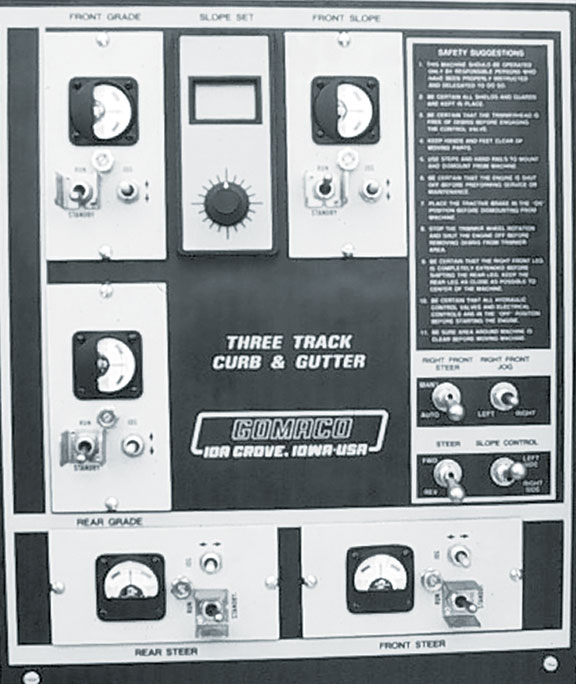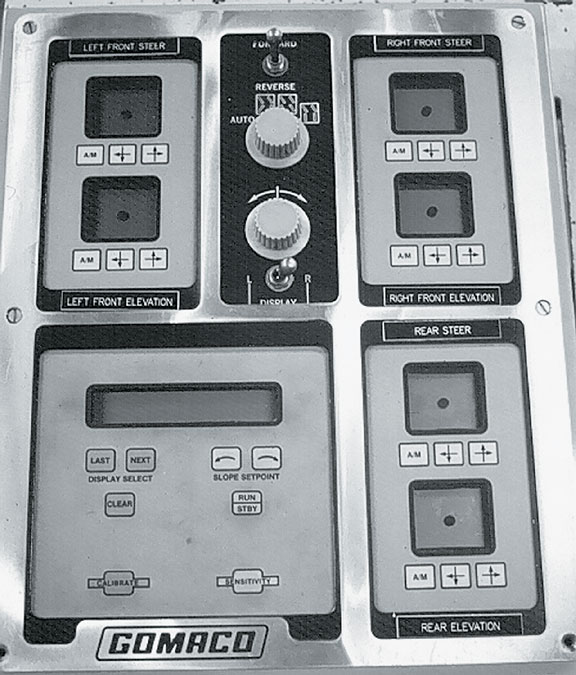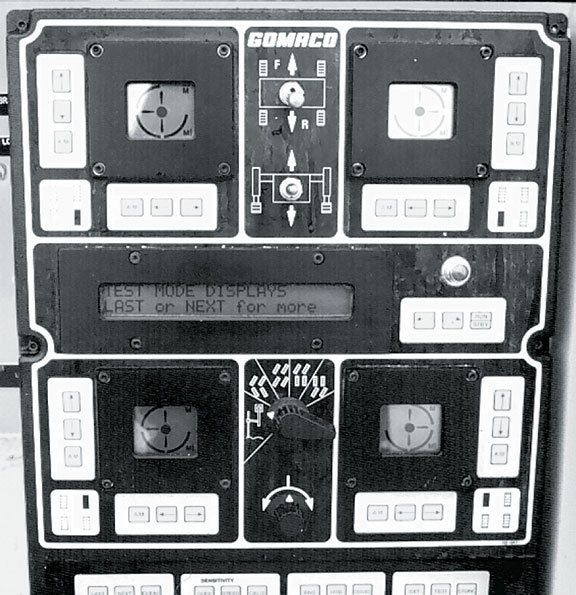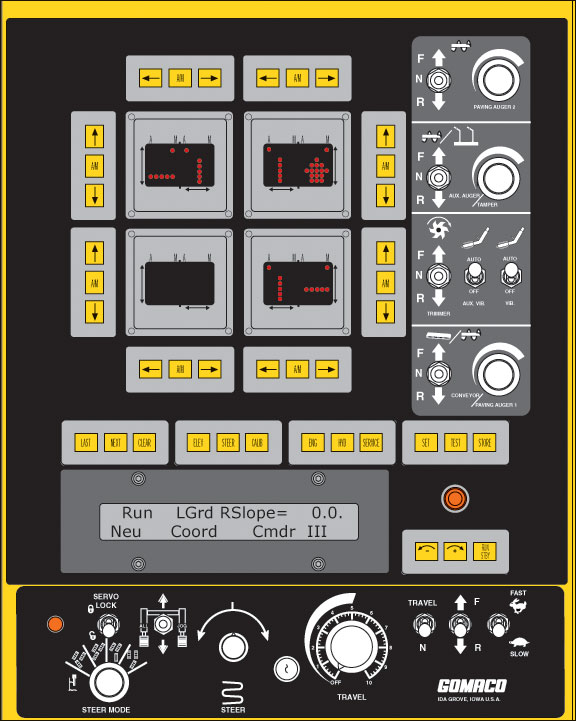GOMACO World Index --- GOMACO World 29.2 - June 2001
G21 - an operating system for the future
GOMACO Corporation has never been content to follow. It's a principle the company was founded on and one that still holds true. You have to value your past to continue being the leaders in the future.
The new G21 controller and digital operating system is an example of the GOMACO philosophy. The very first GOMACO controller consisted of a cork with contacts on it floating in water. It was used for slope control.
The next controller was an on/off grade line control system. It had lights to indicate up and down. Contractors nicknamed the controller the bang-bang system. Adjustments were made by banging the lever up or down according to the direction the lights indicated.
In the early 1970s, Gary Godbersen, GOMACO's president and CEO, was frustrated with the standard controllers of the time. He wanted something better for his machines. GOMACO had designed a new system and turned to Honeywell to help build it.
The result of their partnership was the Analog system, a proportional control system consisting of a sensor, amplifier and servovalve. Control system technology was advancing into the micro processor age and GOMACO took advantage of it.
In 1986, GOMACO introduced the computer-based Micro controller. The Micro was the first programmable controller on the market and, for the first time, had diagnostics to troubleshoot the machine. A new modular hardware controller started development in the 1990s.
The two-wire system controller was introduced in 1993. GOMACO named the new system the Network Controller. The Network is basically a derivative of the Micro, but it has more capabilities. It allows for more diagnostics, more programming and more features. It has a built-in volt meter to monitor the sensor and servovalve voltages and made it possible to change machine set-up parameters such as left grade, right grade, left slope, or dual grade. While GOMACO continued to develop the Network system, the competition kept saying to keep a machine's control system simple and the Network technology was too complicated for contractors. Meanwhile, 99.9 percent of GOMACO's customers chose the Network system over the Analog.
As Network Control technology was being released to other concrete paving manufacturers, GOMACO was looking towards the future.
GOMACO and Sauer Danfoss teams have continued to research and develop the next generation in control systems through the years of the Network. We took advantage of the advancements in digital technology and cost-effective computers' abilities to process and do more while still remaining user-friendly. The result of the years of development and state-of-the-art technology is the G21 controller, GOMACO's new proprietary digital operating system.
"This is a culmination of what we've been doing over the past three decades with control systems," Godbersen said. "The G21 builds on past technologies and it will take us into the future. The G21 is the technology of tomorrow."
The G21 has more computing power than any paver operator ever dreamed of having. It features simple to use push-button steering setup with patented smart cylinders; easy-to-read, red, LED display; more memory; more software and programming capacity; more computing power; more speed; more inputs and outputs; durability; and the list goes on and on.
"The G21 is so exciting because we can now do whatever we can dream of doing and the controller won't be a limiting factor," Kevin Klein, Research and Development manager, said. "With the G21, we can plug-in stringless systems, interface with new technology, and provide pin-point diagnostics at high-end processing speeds. Nobody else can offer what we have in the G21."
People friendly
"We designed this system to be as user-friendly as possible," Jim Homan, assistant manager of GOMACO's Research and Development Department, said. "It's laid out from the you are here standpoint. All you have to do is look at the control panel and it makes sense."
Three displays on the control panel match up with a corresponding leg. Four-track machines have an extra panel. Each display matches the leg in the direction the machine is operating.
Push-button controls next to each display control steering. The Automatic/Manual button is in the middle with buttons on either side for elevation.
Operators simply have to glance down to monitor each leg on their machine. Any corrections can be made by pushing a button.
CAN compatible
The J1939 CAN (control area network) is an industry standard. A particular code number will mean the same thing on any product with a J1939 CAN, whether it's a car engine or a paver engine. When that engine is added to a paver, it can communicate with all the other components on the paver that are J1939 CAN compatible.
GOMACO machines have two CAN networks, a control side CAN and a secondary CAN for future monitoring of oil pressures, water temperature and other functions.
The G21 is the control system of the future and GOMACO designed their new system with that in mind. The CAN controller makes it possible to add options in the future.
If a contractor decides he would like to add a sidebar inserter, for example, to his machine, a CAN controller for the inserter can be added to the existing system. The G21 can then monitor and control the inserter.
"All you're doing is adding options," Homan said. "It gives us countless options. Even as we sit here and discuss it, we can't even guess what we could be doing with it in the future."
Future expansion capabilities
The G21 has a state-of-the-art processor. It can process information faster, and because of this, GOMACO can put more controls into it. It allows for multi-processing or multi-tasking. One computer can support more complex program code and control multiple functions.
"We can load a better program with 20 times more memory," Homan explained. "Plus, because we're not using all of the extra memory, we have room to grow."
Extra program memory also means expandability. Programs can be added for the slope/compensation system, the stringless guidance system, sidebar inserters, and other extra features.
Previous systems have had a limited amount of memory. The existing programs take up all the available space. If contractors wanted to add the slope/compensation system, for example, another component would have to be removed.
It might be simplest to illustrate the G21 in desktop computer terms. Your first computer probably came with a standard 486 processor and 8 megabytes of RAM. It seemed huge at the time, plenty of power and extra memory. Computer technology kept advancing and your standard software grew larger. They required more memory and your computer would sluggishly handle the larger program. Program files outgrew floppy disk capacity but a Zip disk couldn't be added because the computer had no available ports.
New desktop computers no longer have those problems. Now, computers come with 256 megabytes of RAM and Pentium processors. Three or more software programs can be open at once without slowing down processing speed. More software can be added as needed and there's plenty of extra memory. You no longer need a Zip drive because program files can be burned directly to a writable CD drive. If the Zip is still needed, the computer has plenty of extra ports to plug into the back of the machine.
The same is true for the G21, extra memory, faster processing speed, multi-tasking capability, and upgradeability.
Advanced system diagnostics
"You knew something was wrong with the Analog system when it just wouldn't work. You'd hit the jog switch and it didn't jog," Steve Jones, electronic control design research and development, said. "Then we went to the Micro and it had some fault detection. The Network will come up and say there's a short but you didn't know where the short was. The G21 will tell you there's a short in the right-front leg. It pinpoints where the trouble area is and helps you troubleshoot it faster."
The G21 has the ability to look at and monitor each sensor at a rate of 50 times per second.
"It enables us better accuracy because we're constantly monitoring," Homan said. "We can see right away if anything is erroring out and make the needed corrections."
That means less down time for contractors.
"I don't know of any errors that could go wrong with this machine that it can't tell you about," Jones said. "From every wire going into the machine versus every wire going out of it, it knows if a wire is broke, or if a wire is shorted. It knows if something is wrong and it will tell you where to find the problem."
High visibility LED display
One of the concerns contractors had with previous control systems was the deviation meter readouts were difficult to read in direct sunlight. The G21 has a red LED display that can easily be seen in direct sunlight. The LED display is also easy to read because there is no moisture condensation underneath the display.
A series of dots and arrows show the operator what corrections are needed and what direction the correction needs to be made. Five dots in a straight horizontal or vertical line indicate that no correction is needed.
If the machine is in stringline mode, the G21 will automatically make the needed corrections. The size of the arrow indicates the amount of correction needed and it always points in the direction of correction.
External computer systems
The G21's CAN network allows it to be able to communicate with different guidance systems. Its increased processing speeds allow it to multi-task and run the different system programs along with the guidance software.
"The old Network is on a terminal strip," Jones said. "At the hardware level with the G21, we went to real CAN cables so extra applications are plug and play if you have the code to support it."
The true network architecture includes sockets for the extra applications like a stringless guidance system. Contractors simply remove a terminator from the CAN and snap in the extra component.
Other controllers require the extra applications be wired into the Network controller for the stringless converter box.
Push-button setup
Operators can teach the patented smart cylinders where they want them to steer and set electronic cylinder stops to keep the tracks from running into the mold or end product.
"Let's say, with your rear leg, you've got product coming out the back and you're also trimming so there's a windrow. You don't want your rear leg to be in the windrow so you have to be as close as you can to the curb," Homan said. "All you have to do is manually bring that rear leg over to where you want it to stop. Push the store button and the G21 will store that value as being all the way left. You've just taught the smart cylinder how far it can turn. No matter what the operator does, as far as turning, the track will only go as far as the new stored value and never damage the new curb."
All of the smart cylinders are teachable and their values can be reset on the fly. Not all of the legs have to be taught or changed at the same time. Each one can be adjusted and retaught separately.
The increased programming capacity also makes switching from operation modes as easy as pushing a button. If an operator was in transport/barrier mode and now he needs to switch to mainline paving, he just pushes a button. The settings are all pre-programmed into the G21 and make transitions quick and easy.
Smart cylinders and the G21 offer contractors reliable and tight control steering. At the push of a button, operators get an instant and controlled steering response.
Connect the laptop
"From an R&D standpoint, we have software that can monitor everything that's going on with the G21," Homan explained. "We want to get to a point, in the future, where the G21 is actually storing history and we can go up to anybody's machine and download that information. The downloaded information will be extremely helpful as far as troubleshooting the machine, recording production figures and just monitoring the machine in general."
The G21 is upgradeable and additional software and programs can be added to it because it is a CAN-based setup. New software can be downloaded from a laptop computer in the field. The controller will no longer have to be redesigned and redone to accommodate new technology.
The G21 is the control system of the future. With its introduction, GOMACO once again proved why we are the leader in concrete paving technology.
"We're the pioneer, the leader, and everybody else follows us," Dennis Clausen, director of training at GOMACO University, said. "We're not afraid to take a chance and we're not afraid to invest the funds into research and development to design new concepts and provide innovations to the paving industry. If we didn't, we wouldn't have the leadership status that we have today and we would have adopted the attitude to let someone else do the pioneering and we'll follow."
Subscribe to Receive GOMACO World Magazine



